Archives
Categories
- No categories
Meta
-
- Error: Please check if you enter Instagram username and Access Token in Theme Setting > Social Profiles
Fresco Art
Discover an amazing art.

What does the word Fresco mean and what are frescoes?
‘Fresco’ comes from the Italian word ‘al fresco’ and means ‘on the fresh plaster’.
Fresco painting concentrates on mural painting and is executed upon freshly laid, or wet lime plaster. Additionally, water is used as a means for the dry-powder pigment to merge with the plaster, and with the setting of the plaster, the painting becomes an integral part of the wall. In your case the painting will become an integral part of the canvas.
When did the art of fresco painting start?
Fresco painting has been around for centuries. In fact, the earliest art of fresco painting can be traced back to 1600 BC, the Bronze Age in Greece. Ever since these days, the art of producing frescoes has spread and developed, in particularly, in Europe. When we study art, there are references to the frescoes such as in Pompeii, Oplontis and Herculaneum in southern Italy, Florence or Assisi in central Italy.
One of the fathers of the early Renaissance, Cimabue, started producing frescoes in the Basilica of St Francis in Assisi and taught Giotto, his pupil, who became a great early renaissance artist. (Basilica of Santa Maria Novella in Florence and the St Francis Basilica in Assisi.

-
Contact

